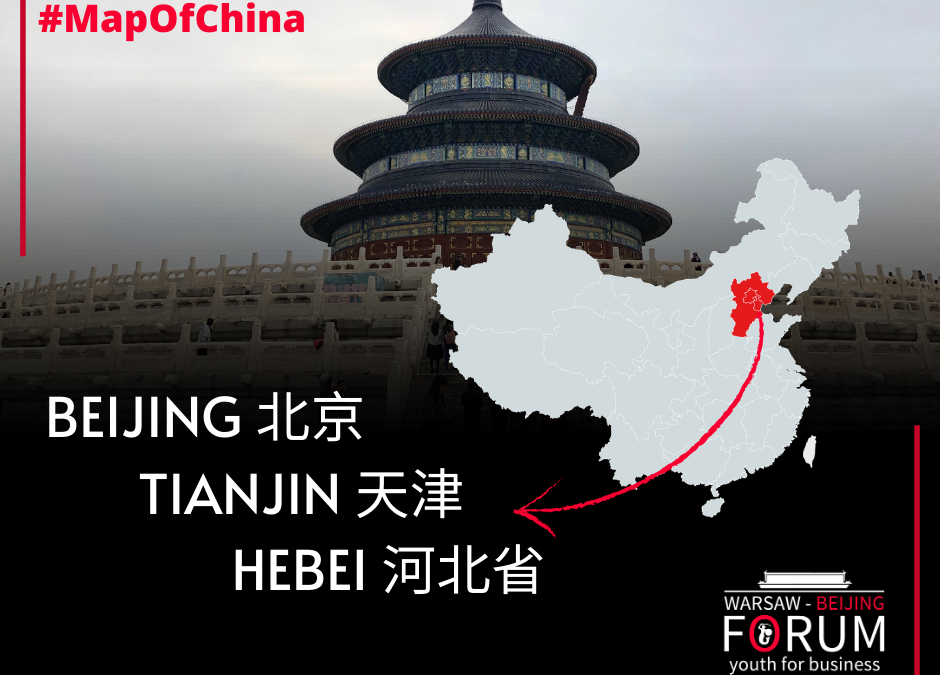From high mountains and glaciers to deep valleys and deserts – China’s geographic diversity is quite astonishing. In this series we will embark on a virtual journey of discovery through various provinces and cities of China. We will get to know the local cuisine, customs, arts and crafts. We will take a look inside ancient temples and down from the top floors of Shanghai’s skyscrapers. The Map of China series is an alternative guide to selected provinces of China. If you are looking for a more unique and local experience and want to discover a different side of China off the beaten path, you may like our selection of provinces and cities.
Beijing (北京)
The capital city of China is undoubtedly one of the world’s leading centers for culture, diplomacy, business, technology and education. Despite being located at the heart of the Hebei province, Beijing (北京) is governed as a municipality under the direct administration of the State Council. The name Beijing means “the northern capital” in Chinese and it was named so by the Ming dynasty emperors who wanted to distinguish it from the southern capital, Nanjing. Beijing has a population of over 20 million people, making it China’s second largest city and one of the world’s most populous cities. Together with Tianjin and the neighboring Hebei lands, it forms the JingJinJi megalopolis. Beijing is one of the oldest continuously inhabited places in the world and it has played a significant part in the Chinese history for over 800 years. It first became the capital of China in the 13th century, during the reign of the Yuan dynasty and has remained so until today except for the brief periods of Nanjing and Chongqing. It is the reason why Beijing hosts numerous world-famous monuments and landmarks like The Forbidden City palace complex, the Temple of Heaven , the Summer Palace, Prince Gong’s Mansion or the Yonghe Temple. Traditional architecture aside, Beijing is also full of state of the art modern buildings like the National Centre for the Performing Arts, the CCTV Headquarters or the supertall China Zun skyscraper which was completed in 2018. The commercial heart of Beijing lies around the Wangfujing Street. Apart from the buildings of the government institutions, Beijing also hosts the headquarters of the state-owned enterprises, as well as the headquarters of the Chinese branches of foreign companies. The best universities in the country such as the Peking University or the Tsinghua University are also located in the city. Beijing has the largest and busiest metro system in the world.
Tianjin (天津)
Tianjin is China’s fourth largest city and the most important manufacturing center and port city of Northern China. Like Beijing, it is a municipality under direct control of the State Council and is part of the Jing-Jin-Ji megalopolis. The city is located at the spot where Ziya and Yongding rivers and the north and south sections of the Grand Canal merge into the Hai River. The name Tiānjīn means “heavenly ford” in Chinese , referring to the legendary crossing of the local river by the Ming dynasty Yongle emperor. In the 19th century, according to the treaties ending the Second Opium War, Tianjin became one of Qing dynasty China’s treaty ports and was open to foreign trade. It is the reason why to this day Tianjin if full of western architecture of the historical neoclassical and art deco styles. Presently, the city is also filled with modern architecture like the Binhai Cultural Center, 530 meter high Tianjin CTF Finance Center, or the almost 600 meter high skyscraper of Goldin Finance 117, which is currently under construction. The city’s main industrial activities are the production of heavy machinery, chemicals, car manufacturing, metalworking as well as shipbuilding and repair. Since 2008, Tianjin is connected with Beijing by high-speed railway and travel between the two cities takes approximately 30 minutes.
Hebei (河北)
Hebei is considered to be one of the most advanced provinces of Northern China, both economically and culturally. The name Héběi means „north of the river” in Chinese due to the province’s location on the northern side of the Yellow River. Geographically the province can be divided into two regions: the northern part of the North China Plain and the mountain ranges along the northern and western frontiers. The regional climate can be distinguished by cold, dry winters and hot, humid summers. With a population of over 74 million people, Hebei is China’s sixth most populous province. Being an integral part of the Jing-Jin-Ji (Beijing-Tianjin-Hebei) Economic Zone and the Bohai Bay Economic Rim, Hebei acts as a significant business center. Hebei is an important agricultural and dairy farming base, however its most productive sector is heavy industry and metallurgy. Since the 1960s Hebei also serves as a major oil producer. The province’s top export products are cotton, fabrics, iron, steel, electrical and mechanical products. It is also the location where the new Xinong’an mega city is being built, which is expected to overtake non-core functions of the Chinese capital in the future. Due to its history of serving as the political heart of China, Hebei is full of monuments and world heritage sites like the Chengde Summer Palace, the Shanhaiguan Pass of the Great Wall of China and the Eastern and Western Tombs of the Qing Dynasty.
Author:
Karol Dulek


Recent Comments